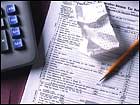|
Tricky tax changes
|
 |
January 24, 2002: 11:13 a.m. ET
Refunds and new tax brackets could make it a tough year for 2001 filers.
By Gary Klott
|
NEW YORK (Tribune Media) - Thanks to several rounds of tax-cutting by Congress over the past few years, this filing season should be less-taxing -- albeit a bit more complicated -- for individuals.
Incorporated in 2001 income tax returns is a host of new and expanded benefits, including a cut in most tax rates, a $100 increase in the child tax credit, and a break for some of the millions of dependents and other taxpayers who didn't receive a full tax rebate check in the mail last year.
Lower-bracket investors are eligible for a new lower capital gains rate for investments held more than five years. More interest on student loans can be deducted. Self-employed individuals can write off more of their business equipment purchases. Most IRS car mileage rates have been boosted.
Middle-income taxpayers will get some additional protection from the dreaded "alternative minimum tax." And most everyone will benefit to some extent from the annual inflation adjustments to the tax system. The biggest changes embedded in 2001 returns reflect the first wave of benefits from President Bush's 10-year, $1.35 trillion Tax Relief Act of 2001.
Other changes stem from tax-cut legislation enacted during President Clinton's second term. For most people, the biggest new law benefit for 2001 was delivered last year. That is when the IRS sent out tax rebate checks of up to $300 for singles, $600 for married couples and $500 for heads of households. The rebates reflected the immediate reduction in the bottom tax bracket. The 2001 tax act lowered the tax rate from 15 percent to 10 percent for the first $6,000 of taxable income for singles, $12,000 for couples and $10,000 for heads of household.
New wrinkles
The new law changes have created new wrinkles in the tax forms that individuals will have to wrestle with. For instance, taxpayers who didn't receive a full rebate check last year will need to fill out a nine-line worksheet to calculate how much, if any, break they're entitled to claim on their 2001 returns to get the benefit of the new 10 percent rate.
Dependents will have a three-line worksheet to fill out. Lower-income parents will need to make some extra calculations to figure their child tax credit. The new law will enable many more parents with modest incomes to reap a benefit from the credit. What is likely to cause the most angst this tax season is the IRS plan to revive the practice of conducting some random audits of taxpayer returns. Normally, individuals are picked for audit based on something suspicious in their return.
But for the first time since 1988, the IRS plans to randomly select nearly 50,000 of this tax season's returns for a special audit. The IRS said this year's random audits would be much less-intrusive and burdensome for taxpayers than the old random audits, which involved exhaustive examination of every line on the taxpayer's return.
Here are some highlights of the changes in 2001 returns:
Tax rates: Each of the tax rates above the 15 percent tax bracket has been lowered a half percentage point.
Capital gains: A new lower capital gains rate of 8 percent applies to most types of investments held more than five years by investors in the 15 percent tax bracket. That compares with a 10 percent rate that normally applies to investments held more than one year by lower-bracket investors.
Student loan deduction: Up to $2,500 in interest paid on college loans in 2001 will be eligible for the student loan deduction, up from $2,000 in 2000.
Kiddie tax: For children under age 14, the first $1,500 of investment income gets preferential tax treatment, up from the first $1,400 in 2000.
IRAs: The income-eligibility limits for traditional IRAs have been raised by $1,000 for workers who are covered by an employer retirement plan.
Business Equipment: Many self-employed individuals and other small businesses will be eligible to immediately write off up to $24,000 of business equipment purchased last year without having to depreciate the costs over a period of years. The previous limit was $20,000.
Car deductions: The IRS standard mileage rate for business use of an automobile increased by 2 cents, to 34.5 cents for 2001. The rate for job-related moves and medical transportation increased by 2 cents, to 12 cents a mile.
Click here for CNN/Money's tax center
Household help: If you paid a housekeeper, gardener or other household helper less than $1,300 last year, you won't have to pay Social Security or Medicare taxes on behalf of the worker. The $1,300 threshold is up from $1,200 in 2000.
Social security tax: Higher-paid workers will find Social Security taxes taking a bigger bite. The 6.2 percent Social Security tax (12.4 percent for the self-employed) will apply to the first $80,400 of job earnings, up from $76,200 in 2000.
Inflation adjustments: The tax tables, personal exemption, earned income credit and other elements of the tax system have been adjusted for inflation. Personal exemptions, for instance, have increased by $100. The standard deduction has increased by $150 for single individuals and by $250 for married couples filing jointly.
Self-employed retirement plans: For self-employed workers, the 2001 deposit limit for defined-contribution Keogh plans increased by $5,000 to $35,000.
Alternative minimum tax (amt): The AMT exemption, which helps protect most taxpayers from being subject to the AMT, increased by $4,000 on a joint return to $49,000, and by $2,000 for singles to $35,750. 
|
|
|
|
|
|

|

